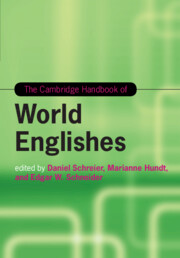Book contents
- The Cambridge Handbook of World Englishes
- Cambridge Handbooks in Language and Linguistics
- The Cambridge Handbook of World Englishes
- Copyright page
- Dedication
- Contents
- Figures
- Maps
- Tables
- Notes on Contributors
- 1 World Englishes: An Introduction
- Part I The Making of Englishes
- Part II World Englishes Old and New
- 7 A Sociolinguistic Ecology of Colonial Britain
- 8 English in North America
- 9 English in the Caribbean and the Central American Rim
- 10 English in Africa
- 11 English in South Asia
- 12 English in Southeast Asia
- 13 World Englishes Old and New: English in Australasia and the South Pacific
- Part III Linguistics and World Englishes
- Part IV Current Challenges
- Index
- References
10 - English in Africa
from Part II - World Englishes Old and New
Published online by Cambridge University Press: 16 December 2019
- The Cambridge Handbook of World Englishes
- Cambridge Handbooks in Language and Linguistics
- The Cambridge Handbook of World Englishes
- Copyright page
- Dedication
- Contents
- Figures
- Maps
- Tables
- Notes on Contributors
- 1 World Englishes: An Introduction
- Part I The Making of Englishes
- Part II World Englishes Old and New
- 7 A Sociolinguistic Ecology of Colonial Britain
- 8 English in North America
- 9 English in the Caribbean and the Central American Rim
- 10 English in Africa
- 11 English in South Asia
- 12 English in Southeast Asia
- 13 World Englishes Old and New: English in Australasia and the South Pacific
- Part III Linguistics and World Englishes
- Part IV Current Challenges
- Index
- References
Summary
English was transplanted to Africa in three different ways. First, through trade contacts along the African West coast, which occurred from the fifteenth century onward, giving rise to pidgin Englishes in West Africa. Second, native varieties in Africa are spoken by descendants of British settlers and others who shifted to English as their native language. The largest settler population is to be found in South Africa where settlement started in the early nineteenth century, alongside Zimbabwe and Kenya. Resettled slaves in Liberia and Sierra Leone developed their own varieties, giving rise in Sierra Leone to Krio, a creole variety that influenced the preexisting pidgin varieties in West Africa. Third, exploitation colonization from the late nineteenth century led to the development of non-native, indigenized varieties of English. Initially, only a small local elite gained access to high proficiency in mission schools but, after independence from the mid-twentieth century, a massive expansion of the national school education granted access to English-language education for a larger part of the indigenous population, albeit with less proficient teachers providing the input, resulting in lower levels of attainment than among the local elites.
- Type
- Chapter
- Information
- The Cambridge Handbook of World Englishes , pp. 210 - 235Publisher: Cambridge University PressPrint publication year: 2020
References
- 2
- Cited by

